Editing Techniques |
  
|
The transparent editing is enabled by default in the T-FLEX CAD for all 2D elements and some of 3D elements. Transparent editing of 2D elements means that elements editing command (similar to the result of selecting the ![]() Edit item in element's contextual menu) is called automatically upon clicking
Edit item in element's contextual menu) is called automatically upon clicking ![]() an element in the 2D window.
an element in the 2D window.
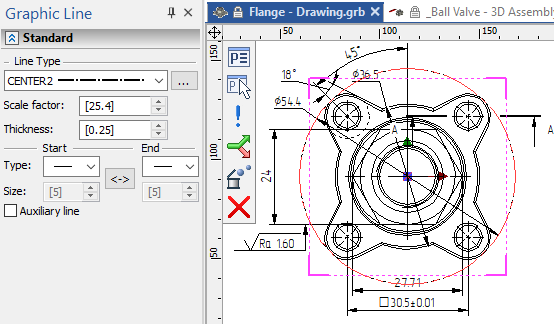
Transparent editing of drawing graphic line
The transparent editing of 2D elements can be disabled by disabling the Transparent element editing checkbox (Options > 2D)
The transparent editing of 3D elements works in a different way. It doesn't call the element editing command, but invokes manipulators in the 3D scene, which can be used for editing an element (e.g.: 3D fragment's transformations manipulators, primitives key dimensions manipulators). The transparent editing is not available for most 3D elements.
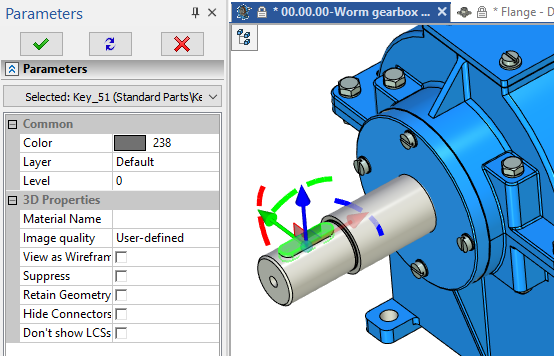
Transparent editing of 3D fragment
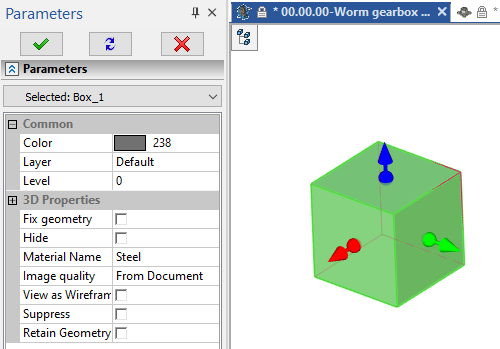
Transparent editing of box primitive
The transparent editing of 3D elements can be disabled by disabling the Allow transparent editing commands checkbox (Options > Additional Options)
Modifying Element's Parameters Without a Rollback
Each system element possesses a certain combination of parameters. One can view and modify those parameters in the element parameters dialog window. This is convenient when the full-function editing command is not required, in avoidance of forcing the system to run a potentially time-consuming recalculation up to the edited element.
Select the desired element to call its parameters dialog. This can be done directly in the 3D or 2D view window, in the ![]() 3D model tree, in the
3D model tree, in the ![]() model elements window or using the
model elements window or using the ![]() Find command. Click
Find command. Click ![]() on selected element to access the contextual menu, and then call the
on selected element to access the contextual menu, and then call the ![]() Parameters command. Element's parameters dialog can also be called by double clicking
Parameters command. Element's parameters dialog can also be called by double clicking ![]()
![]() such element.
such element.
Detailed information on 3D elements' parameters dialogs can be found in the Common Parameters of 3D Elements section. Information on parameters dialogs for elements of other types can be found in chapters describing the particular type of elements. Information on some parameters, which are common for elements of all types, can be found in the General Elements Management chapter.
When selecting the element by clicking ![]() , the
, the ![]() Parameters tool window displays certain parameters which can be modified without calling the dialog. You can handle common parameters of multiple simultaneously selected elements in the same way.
Parameters tool window displays certain parameters which can be modified without calling the dialog. You can handle common parameters of multiple simultaneously selected elements in the same way.
Information on this parameters editing technique can be found in the Define Element Parameters section.
If transparent editing mode is enabled for 2D elements, then this technique is applicable to 2D elements only upon multiple selection.
Edit and Recreate commands
See the Editing and Recreating Elements section.
Elements editing commands
See the Elements Editing Commands section.
Retain Operation Geometry after Recalculation
Upon the activation of the editing and recreating commands, the system rolls back the model to the state in which it was at the time of creating the element. The elements remaining in the scene are those independent from the edited object. When executing a rollback, a part of the model requires regeneration, therefore the command may take some time to activate.
To eliminate this regeneration phase and thus speed up the command activation, you can enable saving the intermediate geometry for a certain operation. This increases usage of computer memory and the model file size to some extent, but helps to speed up editing. In fact, saving geometry can be used as a temporary measure while experimenting with model editing. To enable geometry saving, right-click ![]() the operation (for instance, in the model tree) and choose the Additional >
the operation (for instance, in the model tree) and choose the Additional > ![]() Retain Geometry after Recalculation” item in the context menu. The system will query the user as to when it shall regenerate the model in order to calculate the geometry to be saved - immediately or upon the next recalculation:
Retain Geometry after Recalculation” item in the context menu. The system will query the user as to when it shall regenerate the model in order to calculate the geometry to be saved - immediately or upon the next recalculation:
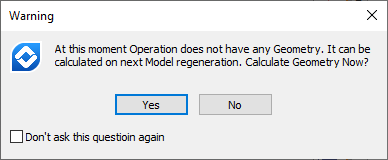
When the Retain Geometry after Recalculation option is enabled, the operation icon in the model tree is marked with the green pin symbol ![]() .
.
Elements Deletion
See the Deleting Elements section.
Source Geometry Editing Command
This command allows to quickly select for editing the geometrical elements used for creating the selected 3D element. The list includes the 2D objects (hatches, 2D paths, 2D nodes, etc.), which were used for creating the selected 3D element and its parent elements. If a 3D element, for example, a 3D profile, was created based on a set of graphic lines on a workplane, then the “geometry” list also includes the workplane itself.
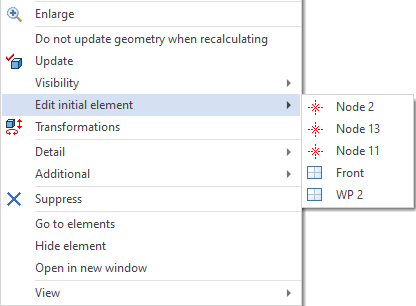
When you select a 2D element in the list of the source geometry, the appropriate drawing page opens and the mode of drawing on the workplane activates; at the same time, the editing command for the selected element is launched. Therefore, this command can be conveniently used to quickly go to the page of the source workplane of a given 3D object.
The ![]() Edit Profile command is available in contextual menu of operations, created from 3D profiles (for example extrusion and rotation), and workplanes, on which 3D profiles were created. The command activates the workplane on which the source 3D profile is located.
Edit Profile command is available in contextual menu of operations, created from 3D profiles (for example extrusion and rotation), and workplanes, on which 3D profiles were created. The command activates the workplane on which the source 3D profile is located.
Handling the Drawing Elements while Editing
When modifying a 3D model, one may often have to deal with drawing elements, since those may be used as references for constructing base 3D model elements (3D profiles, 3D paths, 3D nodes, etc.). The user may proceed with the same editing techniques for 2D elements as one uses when working with a conventional drawing. To modify the shape of a 3D element constructed on the basis of 2D elements, you need to appropriately redefine the source 2D elements. Some of them, for example, hatches directly related with 3D profiles, cannot be deleted and built anew, unless the entire model tree branch is to be deleted together with the children of that hatch. In order to redefine such hatches, one should use the function of editing hatch contours. Otherwise, the model's structural integrity can be broken. If a 3D profile was created based on a set of graphic lines on a workplane, then those lines can be freely modified, including deletion and subsequent new creation. When the session of drawing on the active workplane is over or when the system undergoes the next calculation, the 3D profile will be rebuilt according to the modifications to the graphic lines.
If a certain 2D construction element needs to be modified but cannot be deleted, then you can rebuild it by using another creation method for it in the editing command. The option to rebuild 2D construction elements is available in the automenu of the construction lines editing command.
Sometimes it is helpful to use the ![]() Replace Element command. It allows to transfer all relations with parents and children from one 2D construction element to another one, and then delete the original element. In this case, the other construction element may use a different construction method and maintain its own relations or dependent elements.
Replace Element command. It allows to transfer all relations with parents and children from one 2D construction element to another one, and then delete the original element. In this case, the other construction element may use a different construction method and maintain its own relations or dependent elements.
When creating long chains of element dependencies, the user may run into an attempt of creating a recursive dependency, that is, a dependency of a certain element on itself. In most cases, the system automatically checks the created relations and does not allow saving the changes that cause a recursion. Yet in isolated cases a recursion may occur. Such dependencies are seen most of the times in complex chains of relations like "3D elements - 2D elements - 3D - 2D and so on". One danger of the situation for the user is that the one may save the file with a recursion and not be able to undo the erroneous actions when opening this file later. In such case, it won't be possible to normally work with the file in which the system detects a recursion, up until it is rectified.
In such situation, elements shall be edited in a special way. As was already mentioned, upon an attempt to make any changes, the system will run a check for invalid relations in the modified chain of dependent elements. If such invalid relations are found, the system will disallow the changes. This creates certain complications for the user in one's attempts to delete or edit elements.
The user's goal shall be detecting a recursive relation and breaking the chain of dependencies at any suitable point, all in one editing step. It is often enough to change the definition method of a certain element in the recursive chain. This could be either a 2D or a 3D element. You can redefine the element by changing its definition method - for example, define its position in absolute coordinates or relate it with some other independent elements.
Such elements can be identified with the help of the ![]() diagnostics window - names of elements are indicated in the recursion warning line. Next, you need to investigate the dependencies between the elements - you can call the
diagnostics window - names of elements are indicated in the recursion warning line. Next, you need to investigate the dependencies between the elements - you can call the ![]() Information window for that purpose. After identifying the causes of the recursion, one can proceed to editing. Once corrections are made, run the model recalculation to check and make sure there are no new warnings.
Information window for that purpose. After identifying the causes of the recursion, one can proceed to editing. Once corrections are made, run the model recalculation to check and make sure there are no new warnings.
Techniques of Simplifying the Model Structure and its Display in the 3D Window
T-FLEX CAD system provides means for speeding up primary work processes - this is achieved by freeing additional computer resources when some secondary processes and model details are temporarily dropped.
1.Display simplification:
•Usage of the wireframe display mode in most cases helps the system to recalculate objects in the scene faster and speeds up the scene spinning and object selection;
•The image quality deterioration affects the display of 3D objects in the scene. The objects appear coarser but are drawn faster. The image quality can be controlled via the Image Quality command as well as via the document parameters dialog (Document Parameters > Document > 3D > Mesh Quality)
•You can lower the main system 3D visualization quality (Options > 3D > Graphics Settings)
•Any element in the 3D scene can be made invisible. Reducing the number of elements in the scene helps speed up the display. An element can be hidden by changing the level settings, the layer, or by using the ![]() Hide command in the Visibility sub-menu of the contextual menu invoked by right-clicking
Hide command in the Visibility sub-menu of the contextual menu invoked by right-clicking ![]() the element.
the element.
2.Element Suppression. By suppressing individual operations, the user not just hides them from the 3D scene, but also excludes them from the regeneration process. This also helps reduce the total model regeneration time. An operation can be suppressed by calling the ![]() Suppress command from the contextual menu or by enabling the element suppression in the General tab of the element parameters dialog.
Suppress command from the contextual menu or by enabling the element suppression in the General tab of the element parameters dialog.
3.You can enable the automatic exclusion from visualization for elements, whose size is below the specified value. It is controlled by the Don't show parts smaller than parameter (Document Parameters > Document > Large Assembly Management).
4.You can change the system performance options (Options > Performance) and individual performance options for a certain document (Document Parameters > Document > Performance).